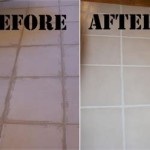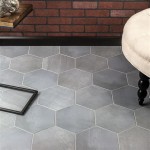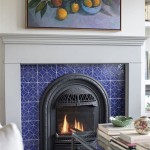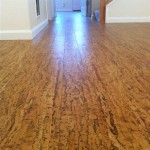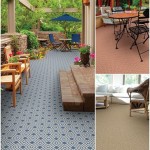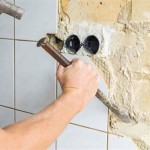Can You Put Backsplash Tile On Painted Drywall Ceiling? Examining the Feasibility and Process
The question of whether backsplash tile can be applied to a painted drywall ceiling is a complex one, involving considerations of structural integrity, adhesive properties, and the overall longevity of the installation. While technically possible in some specific circumstances, it is generally not recommended due to the inherent challenges and potential for failure. This article will dissect the factors influencing this decision, outlining the potential roadblocks and exploring alternative approaches that may be more suitable for different ceiling applications.
The primary purpose of backsplash tile is to protect walls, typically in kitchens and bathrooms, from moisture and splatters. When applied to a ceiling, the function may shift towards aesthetics, sound dampening, or creating a unique design element. However, the weight of the tile and the nature of ceiling surfaces present unique hurdles compared to vertical wall applications.
Before attempting such a project, a thorough understanding of the involved materials and their limitations is crucial. Blindly adhering tile to a painted drywall ceiling without proper preparation and precautions is highly likely to result in the tile eventually detaching and potentially causing damage or injury.
Understanding the Challenges: Weight and Adhesion
The weight of the tile is a critical factor. Ceiling drywall is generally thinner and less dense than wall drywall, and thus has a lower load-bearing capacity. Backsplash tiles, especially those made of heavier materials like stone or glass, can place significant stress on the drywall. Over time, this stress can cause the drywall to sag, crack, or even collapse. The weight limit of the drywall should be confirmed with the manufacturer's specifications.
Furthermore, the painted surface of the drywall presents an adhesion challenge. Paint, especially if it's a glossy or semi-gloss finish, creates a barrier between the tile adhesive and the drywall paper. This barrier can significantly reduce the adhesive's bonding strength, making it more likely for the tiles to detach. Moreover, existing paint may already be compromised by moisture or age, further weakening the adhesion. This is exacerbated by the constant pull of gravity on the tiles, a force not present in typical backsplash installations.
The type of adhesive used is also paramount. Not all adhesives are created equal, and some are specifically formulated for vertical applications. Selecting an adhesive that is designed for overhead surfaces and can bond to painted surfaces is crucial, but even with the right adhesive, the inherent challenges of the weight and the paint layer remain.
Preparation is Key: Evaluating the Surface and Taking Precautions
If undertaking this project, meticulous preparation is essential. First, the ceiling drywall must be thoroughly inspected for any signs of damage, such as cracks, water stains, or sagging. Any existing damage must be repaired before attempting to install the tile. If the drywall is significantly damaged, replacing it entirely with a thicker, more robust option may be necessary. A visual inspection from the attic space above can provide additional insight into the structural integrity of the ceiling supports.
Addressing the paint layer is the next crucial step. The ideal scenario would involve removing the paint entirely by sanding it down to the bare drywall paper. This provides a much more porous surface for the adhesive to bond to. However, sanding drywall can be messy and time-consuming. If sanding is not feasible, thoroughly cleaning the painted surface with a degreaser is necessary to remove any dirt, grease, or oil that could interfere with the adhesive's bonding. Following the degreasing, a specialized bonding primer designed to adhere to glossy surfaces should be applied. This primer creates a more textured surface that the adhesive can grip onto.
In addition to adequate surface preparation, consider bracing the tiles during the adhesive curing process. This can be achieved with temporary supports, such as adjustable poles or wooden shims, to hold the tiles in place until the adhesive has fully set. This prevents the tiles from slipping or detaching due to gravity while the adhesive is still wet. Employing a system of level lines can also ensure that the tiles are installed straight and evenly, minimizing stress points.
Alternative Ceiling Treatments and Considerations
Given the risks associated with applying backsplash tile directly to a painted drywall ceiling, it's prudent to explore alternative ceiling treatments that may offer a similar aesthetic without the same structural concerns. One option is to install a lightweight decorative ceiling panel system. These panels are typically made of materials like PVC or foam, which are significantly lighter than ceramic or stone tile. They can be designed to mimic the look of tile or other textures, providing a similar visual effect without the added weight burden.
Another alternative is to use paint to create a faux tile effect. This involves using stencils or tape to create a pattern that resembles tile, and then painting the pattern onto the ceiling. This option is much lighter and easier to install than actual tile, and it can be customized to match any desired aesthetic. The use of specialized textured paints can further enhance the illusion of depth and dimension.
When considering any ceiling treatment, it's essential to factor in the overall design of the room and the existing architectural features. A ceiling treatment should complement the style of the room and enhance its overall aesthetic appeal. Furthermore, consider the lighting in the room and how it will interact with the ceiling treatment. The choice of materials and finishes can significantly impact the way light is reflected and distributed throughout the space.
If the primary goal is to improve sound dampening, acoustic ceiling tiles or panels are a more suitable option. These materials are specifically designed to absorb sound and reduce noise levels, creating a more comfortable and peaceful environment. Acoustic treatments come in a variety of styles and finishes, allowing them to be integrated seamlessly into the room's design.
Ultimately, the decision of whether or not to apply backsplash tile to a painted drywall ceiling depends on a variety of factors, including the weight of the tile, the condition of the drywall, the type of adhesive used, and the desired aesthetic. While technically possible with meticulous preparation and precautions, the risks associated with this approach often outweigh the benefits. Exploring alternative ceiling treatments that offer a similar aesthetic without the same structural concerns is generally the more prudent and reliable option.
Detailed documentation of the process, including photographs and notes, is advisable if proceeding with tile installation. This documentation can be helpful for future maintenance or repairs. Furthermore, consulting with a qualified contractor or structural engineer is highly recommended before undertaking such a project, especially if there are any concerns about the structural integrity of the ceiling. A professional assessment can provide valuable insights and ensure that the installation is performed safely and correctly.
Consider the long-term maintenance requirements of the chosen ceiling treatment. Some materials may require more frequent cleaning or repairs than others. Choosing materials that are durable and easy to maintain will help ensure that the ceiling continues to look its best for years to come. Weighing the initial cost against the long-term maintenance costs is also an essential consideration.

Going Up Backsplash Tile That Goes To The Ceiling

Can You Tile Over Drywall Master Building Materials Blog

How To Properly Install Tile On Painted Drywall

How To Prepare Drywall For A Tile Backsplash Mr Handyman

How To Prepare Drywall For A Tile Backsplash Mr Handyman

Nitpicky 6 Month Painted Tile Update House Mix

How I Transformed My Kitchen With Paint House Mix

How To Install L And Stick Tile Backsplash On A Wall Angela Marie Made

How To Tile Over Existing Brepurposed

Can Backsplash Go Above Cabinets
Related Posts


